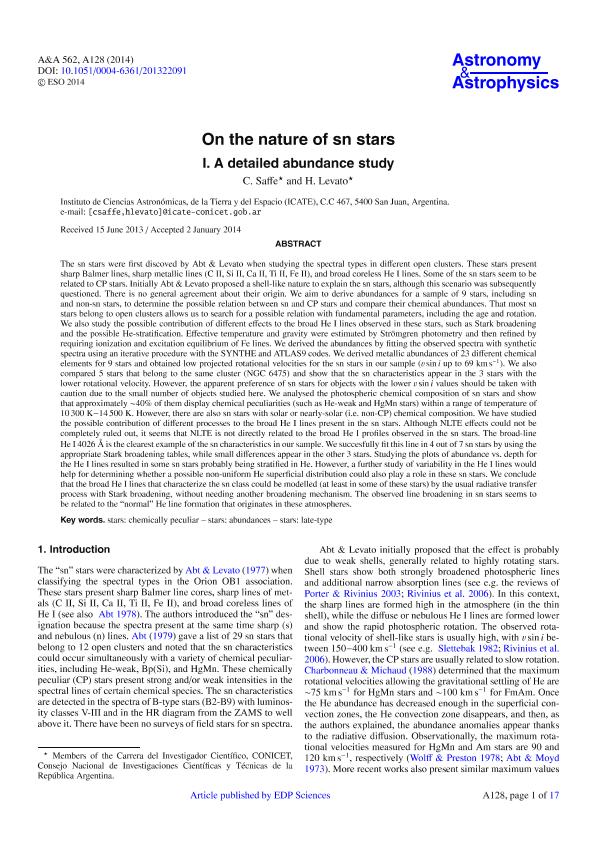Mostrar el registro sencillo del ítem
dc.contributor.author
Saffe, Carlos

dc.contributor.author
Levato, Orlando Hugo

dc.date.available
2016-07-22T18:29:09Z
dc.date.issued
2014-02
dc.identifier.citation
Saffe, Carlos; Levato, Orlando Hugo; On the nature of sn stars. I. A detailed abundance study; EDP Sciences; Astronomy and Astrophysics; 562; 2-2014; 128-145
dc.identifier.issn
0004-6361
dc.identifier.uri
http://hdl.handle.net/11336/6634
dc.description.abstract
The sn stars were first discoved by Abt & Levato when studying the spectral types in different open clusters. These stars present sharp Balmer lines, sharp metallic lines (C II, Si II, Ca II, Ti II, Fe II), and broad coreless He I lines. Some of the sn stars seem to be related to CP stars. Initially Abt & Levato proposed a shell-like nature to explain the sn stars, although this scenario was subsequently questioned. There is no general agreement about their origin. We aim to derive abundances for a sample of 9 stars, including sn and non-sn stars, to determine the possible relation between sn and CP stars and compare their chemical abundances. That most sn stars belong to open clusters allows us to search for a possible relation with fundamental parameters, including the age and rotation. We also study the possible contribution of different effects to the broad He I lines observed in these stars, such as Stark broadening and the possible He-stratification. Effective temperature and gravity were estimated by Strömgren photometry and then refined by requiring ionization and excitation equilibrium of Fe lines. We derived the abundances by fitting the observed spectra with synthetic spectra using an iterative procedure with the SYNTHE and ATLAS9 codes. We derived metallic abundances of 23 different chemical elements for 9 stars and obtained low projected rotational velocities for the sn stars in our sample (vsini up to 69 km s-1). We also compared 5 stars that belong to the same cluster (NGC 6475) and show that the sn characteristics appear in the 3 stars with the lower rotational velocity. However, the apparent preference of sn stars for objects with the lower vsini values should be taken with caution due to the small number of objects studied here. We analysed the photospheric chemical composition of sn stars and show that approximately ~40% of them display chemical peculiarities (such as He-weak and HgMn stars) within a range of temperature of 10 300 K−14 500 K. However, there are also sn stars with solar or nearly-solar (i.e. non-CP) chemical composition. We have studied the possible contribution of different processes to the broad He I lines present in the sn stars. Although NLTE effects could not be completely ruled out, it seems that NLTE is not directly related to the broad He I profiles observed in the sn stars. The broad-line He I 4026 Å is the clearest example of the sn characteristics in our sample. We succesfully fit this line in 4 out of 7 sn stars by using the appropriate Stark broadening tables, while small differences appear in the other 3 stars. Studying the plots of abundance vs. depth for the He I lines resulted in some sn stars probably being stratified in He. However, a further study of variability in the He I lines would help for determining whether a possible non-uniform He superficial distribution could also play a role in these sn stars. We conclude that the broad He I lines that characterize the sn class could be modelled (at least in some of these stars) by the usual radiative transfer process with Stark broadening, without needing another broadening mechanism. The observed line broadening in sn stars seems to be related to the “normal” He line formation that originates in these atmospheres.
dc.format
application/pdf
dc.language.iso
eng
dc.publisher
EDP Sciences

dc.rights
info:eu-repo/semantics/openAccess
dc.rights.uri
https://creativecommons.org/licenses/by-nc-sa/2.5/ar/
dc.subject
Stars: Sn
dc.subject
Stellar Abundances
dc.subject
Abnormal Stars
dc.subject.classification
Astronomía

dc.subject.classification
Ciencias Físicas

dc.subject.classification
CIENCIAS NATURALES Y EXACTAS

dc.title
On the nature of sn stars. I. A detailed abundance study
dc.type
info:eu-repo/semantics/article
dc.type
info:ar-repo/semantics/artículo
dc.type
info:eu-repo/semantics/publishedVersion
dc.date.updated
2016-07-22T13:44:44Z
dc.journal.volume
562
dc.journal.pagination
128-145
dc.journal.pais
Francia

dc.journal.ciudad
Paris
dc.description.fil
Fil: Saffe, Carlos. Consejo Nacional de Investigaciones Cientiâficas y Tecnicas. Centro Cientifico Tecnologico San Juan. Instituto de Ciencias Astronomicas de la Tierra y del Espacio; Argentina
dc.description.fil
Fil: Levato, Orlando Hugo. Consejo Nacional de Investigaciones Cientiâficas y Tecnicas. Centro Cientifico Tecnologico San Juan. Instituto de Ciencias Astronomicas de la Tierra y del Espacio; Argentina
dc.journal.title
Astronomy and Astrophysics

dc.relation.alternativeid
info:eu-repo/semantics/altIdentifier/url/http://www.aanda.org/articles/aa/abs/2014/02/aa22091-13/aa22091-13.html
dc.relation.alternativeid
info:eu-repo/semantics/altIdentifier/doi/10.1051/0004-6361/201322091
dc.relation.alternativeid
info:eu-repo/semantics/altIdentifier/doi/http://dx.doi.org/10.1051/0004-6361/201322091
dc.relation.alternativeid
info:eu-repo/semantics/altIdentifier/arxiv/1401.5764v1
dc.relation.alternativeid
info:eu-repo/semantics/altIdentifier/url/http://arxiv.org/abs/1401.5764v1
Archivos asociados
